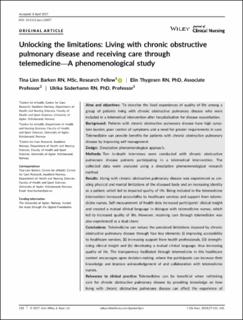| dc.contributor.author | Barken, T. L. | |
| dc.contributor.author | Thygesen, E. | |
| dc.contributor.author | Söderhamn, U. | |
| dc.date.accessioned | 2021-10-13T12:53:31Z | |
| dc.date.available | 2021-10-13T12:53:31Z | |
| dc.date.issued | 2018 | |
| dc.identifier.citation | Barken, T.L., Thygesen, E., & Söderhamn, U. (2018). Unlocking the limitations: living with chronic obstructive pulmonary disease and receiving care through telemedicine - a phenomenological study. Journal of Clinical Nursing, 27(1–2), 132–142. | en_US |
| dc.identifier.uri | https://hdl.handle.net/11250/2799825 | |
| dc.description.abstract | Aims and objectives
To describe the lived experiences of quality of life among a group of patients living with chronic obstructive pulmonary disease who were included in a telemedical intervention after hospitalisation for disease exacerbation.
Background
Patients with chronic obstructive pulmonary disease have high symptom burden, poor control of symptoms and a need for greater requirements in care. Telemedicine can provide benefits for patients with chronic obstructive pulmonary disease by improving self-management.
Design
Descriptive phenomenological approach.
Methods
Ten in-depth interviews were conducted with chronic obstructive pulmonary disease patients participating in a telemedical intervention. The collected data were analysed using a descriptive phenomenological research method.
Results
Living with chronic obstructive pulmonary disease was experienced as creating physical and mental limitations of the diseased body and an increasing identity as a patient, which led to impaired quality of life. Being included in the telemedicine intervention increased accessibility to healthcare services and support from telemedicine nurses. Self-measurement of health data increased participants’ clinical insight and created a mutual clinical language in dialogue with telemedicine nurses, which led to increased quality of life. However, receiving care through telemedicine was also experienced as a dual chore.
Conclusions
Telemedicine can reduce the perceived limitations imposed by chronic obstructive pulmonary disease through four key elements: (i) improving accessibility to healthcare services, (ii) increasing support from health professionals, (iii) strengthening clinical insight and (iv) developing a mutual clinical language, thus increasing quality of life. The transparency facilitated through telemedicine in this healthcare context encourages open decision-making, where the participants can increase their knowledge and improve acknowledgement of and collaboration with telemedicine nurses.
Relevance to clinical practice
Telemedicine can be beneficial when rethinking care for chronic obstructive pulmonary disease by providing knowledge on how living with chronic obstructive pulmonary disease can affect the experience of receiving care through telemedicine and further determine for whom telemedicine is useful. | en_US |
| dc.publisher | Journal of Clinical Nursing | en_US |
| dc.subject | Chronic Obstructive Pulmonary Disease | en_US |
| dc.subject | nursing | en_US |
| dc.subject | patient experience | en_US |
| dc.subject | phenomenology | en_US |
| dc.subject | quality of life | en_US |
| dc.subject | self-management | en_US |
| dc.subject | telemedicine | en_US |
| dc.subject | velferdsteknologi | en_US |
| dc.subject | avstandsoppfølging | en_US |
| dc.title | Unlocking the limitations: living with chronic obstructive pulmonary disease and receiving care through telemedicine - a phenomenological study | en_US |
| dc.type | Journal article | en_US |
| dc.source.pagenumber | 132–142 | en_US |
| dc.source.volume | 27 | en_US |
| dc.source.journal | Journal of Clinical Nursing | en_US |
| dc.source.issue | 1-2 | en_US |
| dc.identifier.doi | https://doi.org/10.1111/jocn.13857 | |
| dc.description.localcode | måsjekkes | |
